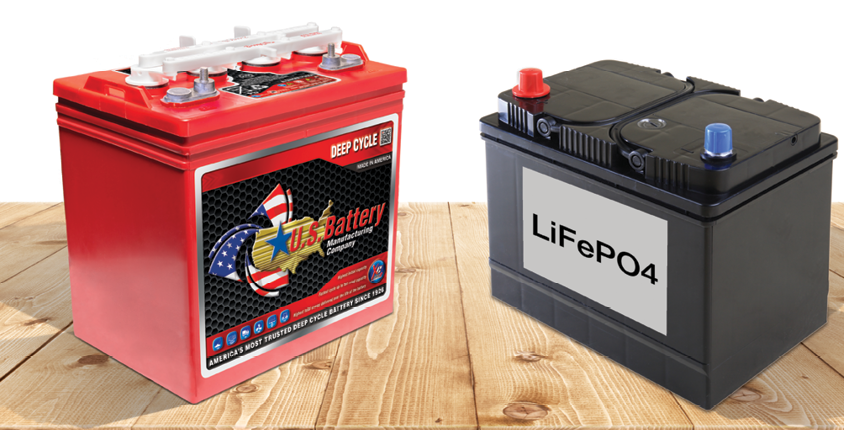
For decades, deep-cycle flooded lead-acid batteries have been the most cost effective means to power electric golf cars. With the success of Lithium-ion batteries in many devices and now in vehicles like Tesla cars, many have looked into what Lithium can do to reduce costs for the golf course market.
Those anxious to make the conversion have put out information from the lithium industry, showcasing the cost comparisons and the advancements this technology brings. According to battery technology publications and many battery manufacturers, however, these comparisons leave out critical information for any golf course management team to make a proper comparison.
In a recent article in the Summer 2017 edition of Battery and Energy Storage Technology Magazine, technical editor Dr. Mike McDonagh points out the half-truths put out by the lithium industry. “Energy densities of current lithium-ion battery chemistries are given at around three to five times the gravimetric and volumetric energy density of lead-acid at the cell level, which in part, explains why the older technology has been all but ignored,” said McDonagh. “Factor in the connectors, spacing in a battery pack, the control and safety equipment, battery management system, fire control, and cooling equipment which are required for the safe operation of larger lithium-ion batteries, and the net result is that an installed working lithium-ion battery will have a working capacity less than one-half its nameplate value.”
Applying this to a typical 48-volt golf car, Fred Wehmeyer, Senior VP of Engineering for U.S. Battery Manufacturing, says that there’s a discrepancy. “When you compare a 240 Ah – 48-volt (11,520 Watt-hr) lead acid battery and a 60 Ah – 48-volt (2880 Watt-hr) lithium ion battery, the lithium-ion battery has a definite weight savings of 422 lbs. at the lower capacity,” says Wehmeyer. “Even without the thermal and battery management safety features, the cost of the lithium-ion pack averages out to $0.42 – 0.52 per watt-hr vs $0.07 – 0.10 per watt-hr for a lead-acid pack. The lithium battery has only 25 percent of the energy of the lead acid battery and can cost up to 50 percent more,” says Wehmeyer.
Translated to the actual driving range of a typical golf car, Wehmeyer suggests that the lithium battery would have 25 percent of the driving range of the lead acid battery. Driving range directly affects depth of discharge (DOD) and as McDonagh pointed out, comparisons are often done in laboratory conditions. “The performance data given in comparisons between lithium-ion and flooded lead-acid batteries are often done with a single cell,” said McDonagh in his article. “The data very conveniently ignores the additional architecture required for safe operation in most installations and it is safety that manufacturers claim are their greatest concern.”
Aside from costs, there are also environmental issues to consider as well. Lithium-ion batteries are not recyclable, whereas the recycling rate of flooded lead-acid batteries in the United States is greater than 99 percent.
According to Wehmeyer, it’s important for anyone making a comparison to add in all of the costs. “A single LiFePO4 cell has a nominal voltage of 3.2-volts, thus requiring eight cells in series for a 24-volt battery pack – double that for a 48-volt system,” said Wehmeyer. “The average retail price of one 100 Ahr (amp-hour) cell is $155, putting the pack cost around $2480 for an average golf car. A compatible BMS and charger cost $290 and $1075 respectively. Altogether, a conversion would cost $3845 and will provide a reported 2000 cycles at a lower energy content of 5120 watt-hours, versus 10,500 watt-hours for a comparable flooded lead-acid battery pack costing about $800. The lead-acid battery would provide twice the runtime for 1/5 the cost.”
“When you take into account environmental cost and safety, on top of the performance issues, the lithium-ion case over lead-acid doesn’t stack up to anything as manufacturers would have you believe,” said McDonagh in his article. “You need to look very carefully at their numbers. Lead-acid is a safe sound and, sadly, overlooked technology that’s 150 years young and completely recyclable.”
While no one is condemning the use of lithium-ion, battery industry officials simply want to make the golf course industry aware that there’s still more homework to be done before lithium-ion can be safely and efficiently adapted to use in this market.
Get curated news on YOUR industry.
Enter your email to receive our newsletters.
Explore the October 2017 Issue
Check out more from this issue and find your next story to read.
Latest from Golf Course Industry
- Beyond the Page 65: New faces on the back page
- From the publisher’s pen: New? No way!
- Indiana course upgrades range with synthetic ‘bunkers’
- Monterey Peninsula CC Shore Course renovation almost finished
- KemperSports and Touchstone Golf announce partnership
- PBI-Gordon Company hires marketing manager Jared Hoyle
- Mountain Sky Guest Ranch announces bunker enhancement project
- GCSAA names Joshua Tapp director of environmental programs






